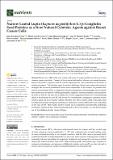Por favor, use este identificador para citar o enlazar a este item:
http://hdl.handle.net/10261/309004COMPARTIR / EXPORTAR:
 SHARE SHARE
 CORE
BASE CORE
BASE
|
|
| Visualizar otros formatos: MARC | Dublin Core | RDF | ORE | MODS | METS | DIDL | DATACITE | |

| Título: | Narrow leafed Lupin (Lupinus angustifolius L.) β-Conglutin seed proteins as a new natural cytotoxic agents against breast cancer cells |
Autor: | Escudero-Feliu, Julia CSIC ORCID; García-Costela, M.; Moreno-SanJuan, S.; Puentes-Pardo, J.D.; Arrabal, S.R.; González-Novoa, P.; Núñez, M.I.; Carazo-Gallego, A.; Jiménez-López, José Carlos CSIC ORCID; León, J. | Palabras clave: | Breast cancer Nutraceutics Cancer stem cells Natural compounds Chemotherapy Apoptosis Viability Oxidative stress Metastasis Resistance |
Fecha de publicación: | 2023 | Editor: | Multidisciplinary Digital Publishing Institute | Citación: | Nutrients 15: 523 (2023) | Resumen: | Breast cancer (BC) is the most widespread tumor in women and the second type of most common cancer worldwide. Despite all the technical and medical advances in existing therapies, between 30 and 50% of patients with BC will develop metastasis, which contributes to the failure of existing treatments. This situation urges the need to find more effective prevention and treatment strategies like the use of plant-based nutraceutical compounds. In this context, we purified three Narrow Leafed Lupin (NLL) β-conglutins isoforms using affinity-chromatography and evaluated their effectiveness in terms of viability, proliferation, apoptosis, stemness properties, and mechanism of action on both BC cell lines and a healthy one. NLL β-conglutins proteins have very promising effects at the molecular level on BC cells at very low concentrations, emerging as a potential natural cytotoxic agent and preserving the viability of healthy cells. These proteins could act through a dual mechanism involving tumorigenic and stemness-related genes such as SIRT1 and FoxO1, depending on the state of p53. More studies must be carried out to completely understand the underlying mechanisms of action of these nutraceutical compounds in BC in vitro and in vivo, and their potential use for the inhibition of other cancer cell types. | Versión del editor: | http://dx.doi.org/10.3390/nu15030523 | URI: | http://hdl.handle.net/10261/309004 | DOI: | 10.3390/nu15030523 | Identificadores: | doi: 10.3390/nu15030523 issn: 2072-6643 |
| Aparece en las colecciones: | (EEZ) Artículos |
Ficheros en este ítem:
| Fichero | Descripción | Tamaño | Formato | |
|---|---|---|---|---|
| 2023_Escudero_N_OA.pdf | 5,08 MB | Adobe PDF |  Visualizar/Abrir |
CORE Recommender
SCOPUSTM
Citations
2
checked on 20-abr-2024
WEB OF SCIENCETM
Citations
2
checked on 28-feb-2024
Page view(s)
34
checked on 16-may-2024
Download(s)
31
checked on 16-may-2024
Google ScholarTM
Check
Altmetric
Altmetric
NOTA: Los ítems de Digital.CSIC están protegidos por copyright, con todos los derechos reservados, a menos que se indique lo contrario.
